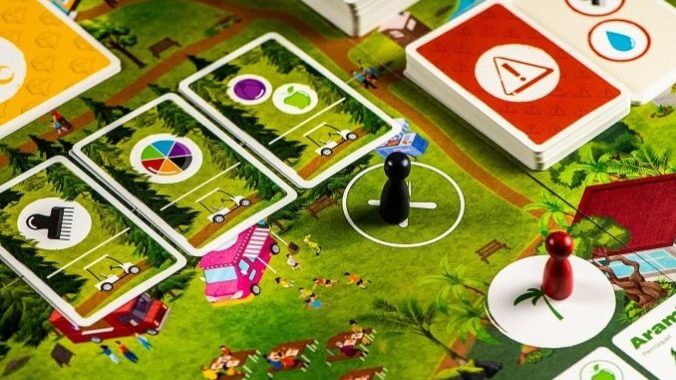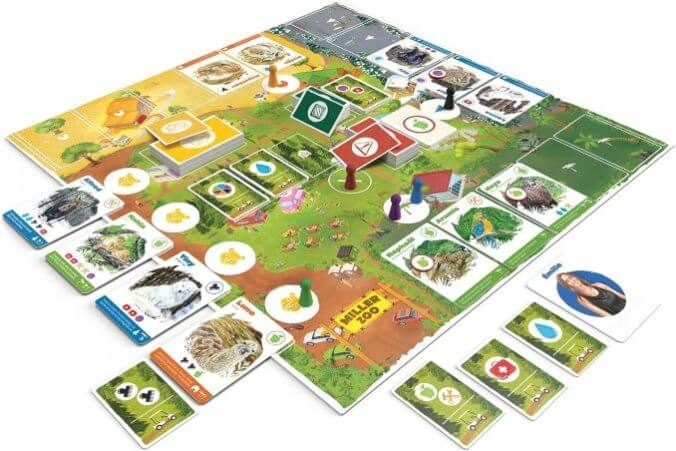
Miller Zoo is a light addition to the roster of cooperative games, with a cute theme and highly customizable play that allows you to tailor the level of difficulty to your player group. Taking its theme from the park of the same name in Frampton, Québec, it asks players to bring new animals into the zoo through resource management, while also dealing with the needs of the very demanding animals already in the zoo on every turn.
The Miller Zoo board has six animals printed on it, two apiece in each of the zoo’s three habitats, and four spaces for cards that show animals you’ll try to ‘receive’ into your zoo. Players work with hands of four resource cards, some showing just one resource and some showing two, and can either use them to fill an animal’s needs, whether a new card in reception or an existing animal that decided it just has to be groomed right now, or to move around the board. Discarding one card lets you move to any other space, whether a different habitat or any of the four reception spaces for new animals, and once on a space you can play as many resource cards as you like to address whatever’s going on there.
Bringing new animals into the zoo requires anywhere from three to seven resources, depending on the card level and how far you’ve played into the game’s optional campaign. Most cards that need five or more resources will take you multiple turns to complete, so you can go to a reception space, fill some of the resource requirements, and then move on and save it for the next turn. There are six resource types in the game, and all players can combine to save up to three resource cards from one round (day) to the next. At the start of each day, each player gets a fresh hand of four cards, and then you turn over one need card per player and add tokens matching the resource(s) shown on those cards to every animal in the zoo that has the same symbol on its upper right corner. Thus as the game progresses and you have more animals in your zoo, the needs you have to address on each turn increase as well.

The catch is that the resource card deck is finite, and if it runs out before you’ve brought all seven new animals into the zoo, you lose. You must complete the final day when you’ve received the seventh animal, which can cause you to exhaust the deck even after you’ve achieved the goal and still lose the game. That’s because the last thing you do on each day, after all players have made their moves, is to address any ‘crises’ caused by failing to remove a need token from any animals already in the zoo. (If Mr. Bonkers doesn’t get his play time, it will indeed be a crisis. Just trust me on this.) You go around the board and for each uncleared token on an animal, you flip cards from the resource deck until you get a matching symbol. You could get lucky and get the right card immediately, but I wouldn’t bet on it, and later in the game it’s possible that the deck won’t have any matching cards left. (There are also wild cards that can match any resource, whether it’s for receiving new animals or taking care of those already in the zoo.)
Turns are simultaneous and since it’s cooperative, players can strategize and coordinate their moves to most efficiently use the cards they have in every round. After you’ve played the first challenge, you get to open additional envelopes that introduce more difficult animal cards, individual player powers (such as one free resource specific to that character that you can use on each turn), and more rules changes, although the campaign itself is optional and you can stop after the first few games that teach you the rules and build you up to Level 3 animal cards. (Level 4 ones are the hardest.) The result is a game that’s incredibly customizable—if you want to play with younger kids, you can stick to Level 1 cards or mix in a Level 2 card or two, while the ‘classic’ game according to the rules is a set that mixes cards from Levels 1 to 3. You can also stick to the first two challenges to play without text if you have younger players who can’t read yet or otherwise have difficulty in that area.
I love cooperative games both for family play and because they’re an easy way to introduce people to better board gaming, with Pandemic the obvious example. As incredible as Pandemic is, though, it’s also reasonably hard for new players, and isn’t as easy to tailor to your table’s skill and age levels. That’s Miller Zoo’s biggest selling point: You can make this as easy or as hard as you’d like. Even a deck of just Level 2 cards will be a reasonable challenge for most players, and if you’ve got an experienced group, or want a difficult solo challenge (where you just play as two players), you can crank it up to Level 3 and 4. The cooperative game space includes a lot of games that just clone Pandemic’s mechanics, but Miller Zoo does it a bit differently, and offers more than enough that’s new to justify making room on your shelf.
Keith Law is the author of The Inside Game and Smart Baseball and a senior baseball writer for The Athletic. You can find his personal blog the dish, covering games, literature, and more, at meadowparty.com/blog.